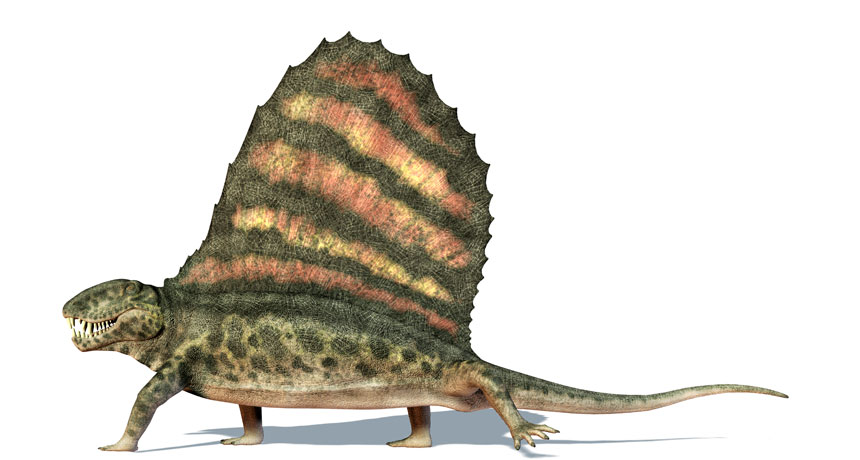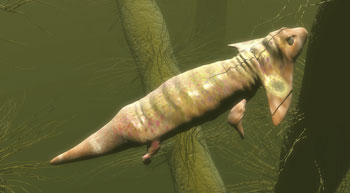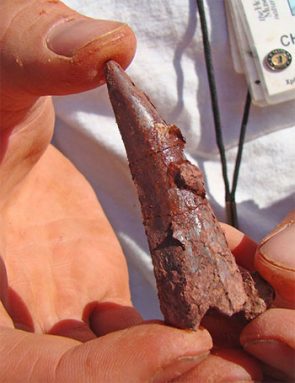This prehistoric meat eater preferred surf to turf
New fossils show the pre-dino Dimetrodon ate sharks and other aquatic animals

Scientists had a good idea what this critter looked like. Now they also know what it ate.
leonello / iStockphoto
By Meghan Rosen
DALLAS, Texas — One of the first big land predators on Earth was roughly the size of a small crocodile. This Dimetrodon (Dih-MEH-truh-don) lived about 280 million years ago — some 50 million years before dinosaurs appeared. And although scientists had a good idea what it looked like, they only now know what fueled it. Rather than dining on plant eaters, the reptilian carnivore ate mainly aquatic animals. Indeed, it probably chowed down on sharks and amphibians like a prehistoric Pac-Man.

Robert Bakker described the dining habits of this snub-nosed, sharp-toothed creature that wore a towering fin on its back. He reported his team’s findings October 14, here, at the annual meeting of the Society for Vertebrate Paleontology. A paleontologist, Bakker works in Texas at the Houston Museum of Natural Science.
The new diet finding is “cool and exciting because it’s completely different from what people thought,” said Stephen Hobe. He’s a paleontologist at Carthage College in Kenosha, Wisc.
For years, scientists thought Dimetrodon fed mainly on plant-eating land critters. “But that turns out to be wrong,” Bakker says.
He and his colleagues spent 11 years cataloging all of the bones and teeth they unearthed in a fossil pit. Located near Seymour, Texas, this pit is nearly the size of two U.S. football fields. It included evidence of ancient ponds and floodplains. The pit also held the remains of 39 Dimetrodons. Surprisingly, it contained fossils of only one each of two different large plant-eaters, creatures that long had been considered prime menu items for Dimetrodons.
These two animals would not have provided nearly enough food to have sustained such a large population of predators, said Christopher Flis. He’s a paleontologist at the Whiteside Museum of Natural History in Seymour. He worked with Bakker on the new project. Other animals must have filled out the Dimetrodon diet, Flis concludes. He and Bakker now argue that those animals were aquatic.

The team unearthed the remains of 134 small sharks. None were as long as Dimetrodon. Still these fish did carry a wicked-looking head spike. The pit also housed the dismembered skulls of 88 Diplocaulus (Dih-plo-KAWL-us). This amphibian had been roughly a meter (about 1 foot) long, with a bulky, boomerang-shaped head. Buried amid this species’ chewed-up bones, researchers found loads of Dimetrodon teeth.
The predator used its teeth to pull amphibians out of the ground — like a gardener yanking up carrots. The heavy head on a Diplocaulus likely popped right off, Flis said. And since “the heads didn’t have that much meat to chew on,” he said, Dimetrodons probably ate the amphibians’ bodies and left mangled remains behind.
Power Words
(for more about Power Words, click here)
amphibians A group of animals that includes frogs, salamanders and caecilians. Amphibians have backbones and can breathe through their skin. Unlike reptiles, birds and mammals, unborn or unhatched amphibians do not develop in a special protective sac called an amniotic sac.
aquatic An adjective that refers to water.
carnivore An animal that either exclusively or primarily eats other animals.
Dimetrodon A reptile that lived around 280 million years ago, well before dinosaurs. It’s body was shaped somewhat like a small crocodile, but with a large scale flaring up from its back. This animal was a meat-eater and probably dined primarily on aquatic animals, from sharks to a meter-long amphibian known as Dipocaulus.
floodplain The nearly flat land that runs along the side of a river, for some distance out from the water. When the river floods, it spills over into this plain, which is built up, over time, with the silt left as the waters recede. That silt tends to be soil that eroded off of the upstream lands during rains.
football field The field on which athletes play American football. Owing to its size and familiarity, many people use this field as a measure of how big something is. A regulation field (including its end zones) runs 360 feet (almost 110 meters) long and 160 feet (almost 49 meters) wide.
paleontologist A scientist who specializes in studying fossils, the remains of ancient organisms.
paleontology The branch of science concerned with ancient, fossilized animals and plants. The scientists who study them are known as paleontologists.
predation A term used in biology and ecology to describe a biological interaction where one organism (the predator) hunts and kills another (the prey) for food.
predator (adjective: predatory) A creature that preys on other animals for most or all of its food.







